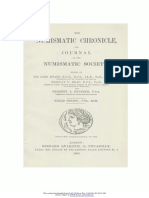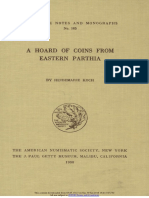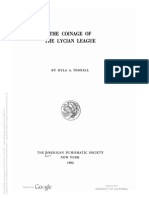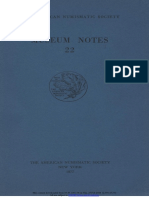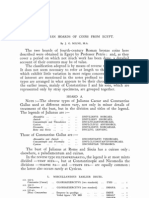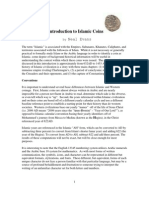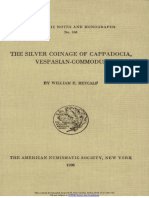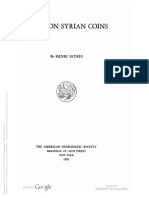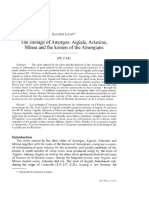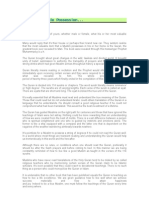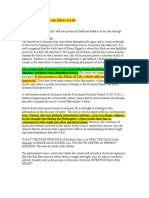A Group of Ottoman 'Dirhem' Weights / Lionel Holland
A Group of Ottoman 'Dirhem' Weights / Lionel Holland
Uploaded by
Digital Library Numis (DLN)Copyright:
Available Formats
A Group of Ottoman 'Dirhem' Weights / Lionel Holland
A Group of Ottoman 'Dirhem' Weights / Lionel Holland
Uploaded by
Digital Library Numis (DLN)Original Title
Copyright
Available Formats
Share this document
Did you find this document useful?
Is this content inappropriate?
Copyright:
Available Formats
A Group of Ottoman 'Dirhem' Weights / Lionel Holland
A Group of Ottoman 'Dirhem' Weights / Lionel Holland
Uploaded by
Digital Library Numis (DLN)Copyright:
Available Formats
Israel
Numismatic
Research
9 | 2014
Published by
The Israel Numismatic Society
Israel Numismatic Research
Published by the Israel Numismatic Society
Editorial Board: Donald T. Ariel (editor), David Wasserstein,
Danny Syon, Ilan Shachar, Oren Tal
Text editor: Miriam Feinberg Vamosh
Plate Layout: Yaniv Schauer
Typesetting: Michal Semo-Kovetz and Yael Bieber,
Tel Aviv University Graphic Design Studio
Printed at Elinir, Tel Aviv
ISSN 1565-8449
Correspondence, manuscripts for publication and books for review should be
addressed to: Israel Numismatic Research, c/o Haim Gitler, The Israel Museum,
P.O. Box 71117, Jerusalem 9171002 ISRAEL, or to dtariel@ins.org.il
Website: www.ins.org.il
For inquiries regarding subscription to the journal, please e-mail to info@ins.org.il
The editors are not responsible for opinions expressed by the contributors.
The Israel Numismatic Society, Jerusalem 2014
Israel Numismatic Research
Published by the Israel Numismatic Society
Volume 9
2014
Contents
5 Erik Waaler: A Sixth-Century Coin from Kos found at Ketef Hinnom,
Jerusalem
15 Haim Gitler and Oren Tal: More Than Meets The Eye: Athenian Owls and
the Chronology of Southern Palestinian Coinages of the Persian Period
29 Danny Syon: A Hoard of Tyrian Silver from orbat Aqrav, Upper Galilee
39 Eric A. Carlen: A Review of the Shechem Hoard
61 Grald Finkielsztejn: The Weight Standards of the Hellenistic Levant, Part
One: The Evidence of the Syrian Scale Weights
95 David M. Jacobson: Herod the Greats Royal Monogram
103 Cecilia Meir: Tyrian Sheqels from the Isfiya Hoard, Part Five: Half Sheqels
with Unclear Dates, Crude-Style Half Sheqels and Augustan Imperial
Denars
109 Yoav Farhi and Alexander Melamed: Two Coin Hoards from Underground
Complexes at Nesher-Ramla Quarry
133 Yinon Shivtiel and Nili Ahipaz: Coins from Cliff Shelters and Hiding
Complexes in Galilee and their Historical and Archaeological Significance
149 Donald T. Ariel, Yuval Baruch and Irina Zilberbod: Out of the North
the Evil Shall Break Forth: Numismatic Evidence for the Besiegers in
Jerusalem during the First Jewish Revolt?
163 Edward L. Mason and Paolo Vison: New Evidence for the 1889 Hebron
Hoard of Bar Kokhba Silver
173 Kate Raphael and Gabriela Bijovsky: The Coin Hoard from Caesarea
Maritima and the 363 CE Earthquake
193 Gabriela Bijovsky, Deborah Sandhaus and Ianir Milevski: A Byzantine
Hoard of Gold Coins from Ashqelon, Barnea BC Neighborhood
213 Lionel Holland: A Group of Ottoman Dirhem Weights
221 Abbreviations
A Group of Ottoman Dirhem Weights
Lionel Holland
lionelholland@gmail.com
Abstract
A group of seven Ottoman dirhem weights of two types is described, and discussed against a
general background of Ottoman historical metrology.
INTRODUCTION
The provinces of the Ottoman Empire, spanning Europe, Asia and Africa, incorporated
an immense cultural diversity. This is reflected in its measuring systems, which
varied from place to place and from one time to another. With no overall single
system, the measuring units applied in the capital at Istanbul might at any given
time be very different from those in daily use in one or another province. Scholarly
attempts to describe Ottoman and other Islamic measuring systems have often
suffered from not having taken such regional and temporal variations sufficiently
into account. Unscrupulous (or, if one feels kindly disposed, merely ill-informed)
compilers of sale catalogues have added to the confusion.
Until the mid-nineteenth century, any move toward standardization of weights
and measures throughout the Ottoman Empire met with failure (Inalcik 1983;
Gnergun 2009). Even after that time, the steps taken toward that end were never
more than partially successful, right up to the dissolution of the empire at the end
of World War 1.
The study of Ottoman measuring systems is fraught with problems. A number
of these are discussed in an invaluable paper by Inalcik (1983). Until very recently,
such studies did not attract much scholarly attention, and the useful literature was
very scanty. In the past decade, this situation has begun to change. Krkmans book
Anatolian Weights and Measures (2004) is a detailed, superbly illustrated survey of
several hundred specimens of measuring equipment (mainly scales and weights),
most of which are Ottoman. More recently, Ouz Tekin has undertaken the task
of cataloguing all ancient weights (Greek, Roman, Byzantine and Islamic) in all
of Turkeys museums. This will make thousands of weights, until now accessible
only to a very few, known to researchers, and should do much to help provide a
sounder base than hitherto, for the study of Ottoman metrology.
Much useful information about Seljuk and Ottoman weights is to be found in
two valuable papers by Nancy S. Pyle (1977; 1978), which, unlike much of the
earlier literature concerning Islamic metrology, are firmly based on the careful
examination, measurement and analysis of as many available specimens as possible.
The brief summary that follows owes much to Pyles work.
INR 9 (2014): 213219
213
214
LIONEL HOLLAND
Two important weight units used by the Othmanli, or Ottoman Turks, were the
okka and the dirhem. The Seljuks of Rum, who ruled much of Anatolia between the
eleventh and thirteenth centuries CE, used flat, handsomely decorated, cast, ringshaped weights of copper alloy, made in decimal multiples of a dirhem (roughly
3.2 g; Pyle 1978). Pyle listed weights of 400, 200, 100, 50, 25 and 10 dirhems.
Subsequently gaining ascendancy in Anatolia, the Othmanli continued to use similar
ring-shaped weights, also in decimal multiples of a dirhem (Pyle 1977). The unit
of 400 dirhems was called an okka (not to be confused with wuqiyah, Arabic for an
ounce). The absolute mass of the okka could vary, depending on when and where
in the empire weights were made and used. Krkman described and illustrated a
variety of okka weights in use at different times throughout Ottoman history. The
earliest are actually revalidated Seljuk pieces.1
The dirhem was originally a silver coin used by the Sasanians, and subsequently
by the Arabs. The name eventually became associated with a unit of weight of
central importance in all Islamic ponderal systems. Its mass varied between about
2.5 and 3.5 g, depending on time and place.
Krkman illustrated a number of different forms of Ottoman dirhem weights. The
largest of these are of 200 dirhems, which, in addition to serving as coin weights,
may have been used for weighing bullion, and merchandise of high value. The
commonest (certainly those most often seen in Israel) are the two types illustrated
below. All the weights described here are unprovenanced and were acquired in Israel.
FLAT WEIGHTS WITH EIGHT SIDES (KRKMAN TYPE N)
Octagonal flat coin weights were (very infrequently) used by the Byzantines (Holland
2009:29, No. 60). From the Arab period, Balog lists a few inscribed Fatimid and
Ayyubid specimens, all multiples of a mithqal or dinar of about 4.25 g, probably
used for weighing gold (Balog 1970:252253, Nos. 2832; Balog 1973, Pl. 2:45);
and an anonymous 5-mithqal specimen that he tentatively attributes to a Mamlk
amir (Balog 19801981:128, No. 22).
The shape was apparently used in Persia by the Great Seljuks (Balog 1973)2,
from whom it presumably passed to the Seljuks of Rum, and thence to the Othmanli
who used it for the dirhem.
The form of weights used by the Seljuks, before the rise of the Ottomans, is
illustrated for purposes of comparison in Fig. 1. It shows a flat, octagonal Seljuk
1 These saucer-shaped weights continued to be used in parts of the former Ottoman
Empire, right up to modern times. Some of the purported very rare ancient Ottoman
okka weights offered on eBay and sometimes stamped in Greek, are, in fact, weights
in common use in Cyprus well into the twentieth century.
2 Balog assigns a Persian origin for these, chiefly due to their style and elaborate
ornamentation.
GROUP OF OTTOMAN DIRHEM WEIGHTS
215
weight with fluted sides (Tekin 2013). The Arabic inscription, translated, reads
Great Sultan Kilij Arslan, son of Mesud. Kilij Arslan II was ruler of the Seljuks
of Rum from 1156 to 1192 CE. Based on the specimens reported mass of 21.16
g, Tekin considered the weights likeliest denomination to be 5 miskal (a unit used
for weighing gold).3
Fig. 1. Seljuk weight naming Kilij Arslan II, 21.16 g, 21 mm (Photo: Ouz Tekin; 2:1 scale)
The earliest octagonal Ottoman dirhem weights known to Pyle (1977), and also the
earliest described by Krkman (2004:6365), bear the tughra of Sultan Suleiman I
(15201566 CE). A series of octagonal weights from 1 to 200 dirhems, multiplied
decimally, is illustrated in Krkmans book (p. 71; Fig. 2). Dates and names on
some of these indicate that they continued to be made and used throughout most of
the Ottoman period. They are, on the whole, plain, lacking the elaborate decoration
found on Persian weights.
Fig. 2. Two 1-dirhem weights from Krkman 2004 (a). bearing the tughra of Sulaymn I b.
3 I am indebted to Ouz Tekin for permission to use the photograph, and for his comments.
216
LIONEL HOLLAND
Selm I Qnn (The Magnificent; AH 926974 / 15201566 CE); 3.19 g, 14.5 mm (p. 234,
No. 124); (b). bearing the tughra of Abdl Mejid and the date AH (1)267 / 1851 CE) ; 3.10 g,
2527 mm (p. 278, No. 302) (2:1 scale)4
Three octagonal pieces are shown in Fig. 3). Two are dated. The general similarity
of the 50-dirhem weight to the other two suggests that it was probably issued in
the same period as the others, i.e., during the early and mid-nineteenth century CE.
Fig. 3. Three octagonal dirhem weights5
Letter
a
b
c
Mean
Denomination
50 dirhems
20 dirhems
10 dirhems
Mass (g)
159.60
64.06
31.72
Date (AH)
Illegible
(1)279 (1863 CE)
(1)247 (1832 CE)
Calc. dirhem (g)
3.19
3.20
3.17
3.19
BEVELED CUBES (KRKMAN TYPE F)
These are called cubo-octahedral weights by Kisch and Balog, but I think the
name beveled cubes describes them more accurately.
I know of no occurrence of this shape among ancient weights of Greek, Roman
or Byzantine origin. Its earliest appearance known to me is on a lone 5-dirhem
specimen found at Caesarea in Israel (Holland 1986:194, No. 53), with a terminus
ante quem in the mid-thirteenth century CE, and a probable Fatimid origin. Clearly
4 Images courtesy of the Suna and Inan Kira Foundation, Anatolian Weights and
Measures Collection, Pera Museum, Istanbul, and may not be further copied or
reproduced without their prior permission.
5 Specimens were weighed with a Sartorius L2200P top-loading balance reading to 0.01 g,
or with a Mettler Type 15 macrobalance reading to 0.1 mg. (In many papers concerning
ancient weights, no information is provided regarding the weighing equipment and
methods used. Such an omission seems questionable to the present writer.)
GROUP OF OTTOMAN DIRHEM WEIGHTS
217
not a favorite with the Fatimids, this shape was adopted by the Othmanli. Krkman
illustrated (p. 76) a series from 1 to 100 dirhems, in decimal multiples. Names and
dates on some of them indicate that they were used for centuries, coevally with
the octagonal weights.
The four pieces illustrated in Fig. 4 bear no inscriptions. They are attractively
decorated with rosettes and geometrical shapes.
Fig. 4. Four beveled-cube dirhem weights
d
e
f
g
Mean
Letter
Denomination
50 dirhem
20 dirhem
10 dirhem
2 dirhem
Mass (g)
146.3
61.22
31.74
5.91
Calc. dirhem (g)
2.93
3.06
3.17
2.95
3.03
The mean masses of the two samples (of octagonal weights and bevelled cubes
respectively) are different. A simple comparison of means (Students t-test) reveals
that the difference is not statistically significant.
STANDARDS
When discussing ancient weights, it is pointless to speak of standards in a modern
sense, i.e., of an official, strictly defined primary standard, against which all other
weights were to be measured and to which they must conform. Standards of this
kind have only developed relatively recently. Writers sometimes assert that such
a primary weight standard was kept by the Romans in a temple in Rome. But
327.45 g was never the standard weight of the Roman pound. It was simply a
convenient mean value, calculated from a sample of coins, weighed some 150
years ago by European scholars, and stated with a precision that no Roman balance
could possibly achieve. A different sample might have given a different standard.
For tax gathering purposes, the standard measure applied at any particular
location would have been whatever apparatus the local tax collector used. There
218
LIONEL HOLLAND
are several known instances in the ancient world of ostensibly standard weighing
and measuring apparatus, which deviated grossly from usually accepted values
(e.g., the Carvoran corn measure [Skinner 1967], or the fourth-century coin weights
in the box found in the Egyptian desert by Petrie [Petrie 1926]), and which were
very probably deliberately falsified for purposes of profit. Likewise, in any ancient
marketplace, the standard for weights and measures would be whatever equipment
the local agoranomos, or mutasib, or other official, was using.
In the case of Ottoman Turkey, we are told (Gnergun 2009) that precisely
defined standards of measurement (in the modern sense) were first applied in
Istanbul around the beginning of the nineteenth century, in the states armaments
manufacturing industry. The definition of the dirhem as having a mass of 3.207 g
was made later in the nineteenth century, near the time of the official adoption of
the metric system by the Othmanli. Any attempt at defining a standard Ottoman
dirhem with a precision closer than 0.050.1 g, at any given location or at any
given period in history earlier than this, is bound to end in uncertainty. If, and
when, a sufficient number of firmly provenanced specimens become available, it
may become possible to identify and define local differences in time and place. It
is already known, for instance, from records of measurements made on weights in
use at the time, that a dirhem close to 3.1 g was in use in Alexandria at the end of
the eighteenth century and later (Mahmoud Bey 1873).6 Let us hope that with the
systematic measurement and cataloguing of more and more surviving specimens,
further light may eventually be thrown on the history of weights and measures in
different parts of the Ottoman Empire.
REFERENCES7
Balog P. 1970. Islamic Bronze Weights from Egypt. Journal of the Economic and Social
History of the Orient 13/3:233256.
Balog P. 1973. Pesi di Bronzo Islamici del XIII Secolo. Quaderni Ticinesi, Numismatica e
Antichit Classiche 2:179187.
Balog P. 19801981. Contributions to the Arab Metrology and Coinage. Annali dell Istituto
Italiano di Numismatica 2728:115135.
6 Mahmoud Bey cited the work of Napoleons commission of savants, published in
LaDescription de lEgypte, p. 32.
7 Of the publications listed here, the following are available online, all accessed
August 7, 2014: Holland 1986; 2009; Mahmoud Bey El Falaki; Rum Toplumsal
Tarih 238; and Tekin 2013 (all online at www.academia.edu); Gnergun 2009
(http://psi424.cankaya.edu.tr/uploads/files/Agoston%20and%20Masters,%20
Enc%20of%20Ott%20Empire.PDF); Inalcik 1983 (http://www.inalcik.com/images/
pdfs/33649423OTTOMANMETROLOGY.pdf).
GROUP OF OTTOMAN DIRHEM WEIGHTS
219
Gnergun F. 2009. Weights and Measures. In G. Agoston and B.A. Masters eds. Encyclopedia
of the Ottoman Empire. New York. P. 595.
Holland L. 1986. Islamic Bronze Weights from Caesarea Maritima. MN 31:171201.
Holland L. 2009. Weights and Weight-Like Objects from Caesarea Maritima. Hadera.
Inalcik H. 1983. Introduction to Ottoman Metrology. TURCICARevue dtudes Turques
15:311348.
Krkman G. 2004. Anatolian Weights and Measures. Istanbul.
Mahmoud Bey (El Falaki). 1873. Le systme mtrique actuel dgypte. Journal Asiatique
1 (7th series):67110.
LaDescription de lEgypte XVII: LaDescription de lEgypte, ou, recueil des observations et
des recherches qui ont t faites en gypte pendant lexpedition de larme franaise
XVII. tat Moderne. (2nd ed.) Paris 1824.
Petrie W.M.F. 1926. Ancient Weights and Measures (reprint 1974). London.
Pyle N.S. 1977. Ottoman Okka Weights. Belleten Turk Tarih Kurumu Ankara 41/161:115132.
Pyle N.S. 1978. Anatolian Ring Weights. Journal of Turkish Studies 2:97106.
Skinner F.G. 1967. Weights and Measures: Their Ancient Origins, and Their Development in
Great Britain up to A.D. 1855. London.
Tekin O. 2013. A Weight Bearing the Name of Kilicarslan II, the Great Sultan of the Seljuks
of Rum. Toplumsal Tarih 238 (October):4849.
You might also like
- What The Ladybird Heard Activity Sheet Pack OnlineDocument18 pagesWhat The Ladybird Heard Activity Sheet Pack OnlineDinh PhamNo ratings yet
- Pounds, Norman - The Medieval City, Greenwood 2005 PDFDocument265 pagesPounds, Norman - The Medieval City, Greenwood 2005 PDFAdrian Stănilă100% (3)
- The History of Childrens LiteratureDocument23 pagesThe History of Childrens Literatureun_arandanos100% (4)
- The Watchtower - 1944 IssuesDocument385 pagesThe Watchtower - 1944 Issuessirjsslut100% (1)
- On Two Coins of Muzaffar Ghāzī, Ruler of Maiyāfāriqīn (A.H. 617-642/A.D. 1220-1244) / (Oleg Grabar)Document13 pagesOn Two Coins of Muzaffar Ghāzī, Ruler of Maiyāfāriqīn (A.H. 617-642/A.D. 1220-1244) / (Oleg Grabar)Digital Library Numis (DLN)No ratings yet
- The Coins of The Sháhs of Persia, Safavis, Afgháns, Efsháris, Zands, and Kájárs / by Reginald Stuart PooleDocument481 pagesThe Coins of The Sháhs of Persia, Safavis, Afgháns, Efsháris, Zands, and Kájárs / by Reginald Stuart PooleDigital Library Numis (DLN)No ratings yet
- Greek Coins Acquired by The British Museum in 1892Document23 pagesGreek Coins Acquired by The British Museum in 1892Digital Library Numis (DLN)No ratings yet
- A Hoard of Coins From Eastern Parthia / by Heidemarie KochDocument99 pagesA Hoard of Coins From Eastern Parthia / by Heidemarie KochDigital Library Numis (DLN)No ratings yet
- Account of A Hoard of Roman Coins Found Near Luton Bedfordshire / by John EvansDocument9 pagesAccount of A Hoard of Roman Coins Found Near Luton Bedfordshire / by John EvansDigital Library Numis (DLN)No ratings yet
- Notes On The Imperial Persian Coinage / G.F. HillDocument17 pagesNotes On The Imperial Persian Coinage / G.F. HillDigital Library Numis (DLN)No ratings yet
- The Alexander Coinage of Sicyon / Arr. From Notes of Edward T. Newell With Comments and Additions by Sydney P. NoeDocument62 pagesThe Alexander Coinage of Sicyon / Arr. From Notes of Edward T. Newell With Comments and Additions by Sydney P. NoeDigital Library Numis (DLN)No ratings yet
- Byzantine Miliaresion and Arab Dirhem: Some Notes On Their Relationship / (George C. Miles)Document37 pagesByzantine Miliaresion and Arab Dirhem: Some Notes On Their Relationship / (George C. Miles)Digital Library Numis (DLN)100% (1)
- A Mamluk Bronze Weight in The Israel Museum Collection / Warren C. Schultz and Haim GitlerDocument17 pagesA Mamluk Bronze Weight in The Israel Museum Collection / Warren C. Schultz and Haim GitlerDigital Library Numis (DLN)No ratings yet
- Greek Coins Acquired by The British Museum in 1890 / by Warwick WrothDocument21 pagesGreek Coins Acquired by The British Museum in 1890 / by Warwick WrothDigital Library Numis (DLN)No ratings yet
- Constans II Bust in CoinsDocument7 pagesConstans II Bust in CoinsgigajohnNo ratings yet
- Some Hoards and Stray Finds From The Latin East / D.M. MetcalfDocument27 pagesSome Hoards and Stray Finds From The Latin East / D.M. MetcalfDigital Library Numis (DLN)100% (1)
- A Third Century Hoard of Tetradrachms From Gordion / Dorothy Hannah CoxDocument43 pagesA Third Century Hoard of Tetradrachms From Gordion / Dorothy Hannah CoxDigital Library Numis (DLN)No ratings yet
- Touratsoglou, Coin Production and Circulation in Roman Peloponesus PDFDocument23 pagesTouratsoglou, Coin Production and Circulation in Roman Peloponesus PDFCromwellNo ratings yet
- The Coinage of The Lycian League / by Hyla A. TroxellDocument322 pagesThe Coinage of The Lycian League / by Hyla A. TroxellDigital Library Numis (DLN)100% (1)
- A Hoard of Byzantine Folles From Beirut / Paul BeliënDocument9 pagesA Hoard of Byzantine Folles From Beirut / Paul BeliënDigital Library Numis (DLN)No ratings yet
- The Coinage of Pisidian Antioch / (G.F. Hill)Document19 pagesThe Coinage of Pisidian Antioch / (G.F. Hill)Digital Library Numis (DLN)No ratings yet
- Excavation Coins From The Persepolis Region / by George C. MilesDocument155 pagesExcavation Coins From The Persepolis Region / by George C. MilesDigital Library Numis (DLN)No ratings yet
- A New Cleopatra Tetradrachm of Ascalon / Agnes Baldwin BrettDocument13 pagesA New Cleopatra Tetradrachm of Ascalon / Agnes Baldwin BrettDigital Library Numis (DLN)100% (1)
- Notice On The Dinârs of The Abbasside Dynasty / by Edward Thomas RogersDocument55 pagesNotice On The Dinârs of The Abbasside Dynasty / by Edward Thomas RogersDigital Library Numis (DLN)No ratings yet
- The Coinage of The Tulunids / by Oleg GrabaDocument97 pagesThe Coinage of The Tulunids / by Oleg GrabaDigital Library Numis (DLN)100% (1)
- The Coinage of The Mamlūk Sultan Baybars I: Additions and Corrections / Michael L. BatesDocument25 pagesThe Coinage of The Mamlūk Sultan Baybars I: Additions and Corrections / Michael L. BatesDigital Library Numis (DLN)No ratings yet
- The Ottoman Coinage of Tilimsan / Michael L. BatesDocument15 pagesThe Ottoman Coinage of Tilimsan / Michael L. BatesDigital Library Numis (DLN)100% (1)
- Athenian Tetradrachms Recently Discovered in The Athenian Agora / John H. KrollDocument9 pagesAthenian Tetradrachms Recently Discovered in The Athenian Agora / John H. KrollDigital Library Numis (DLN)No ratings yet
- Arsacid, Elymaean and Persid Coinage, Khodadad RezakhaniDocument12 pagesArsacid, Elymaean and Persid Coinage, Khodadad RezakhaniOmidNo ratings yet
- Royal Greek Portrait Coins: Being An Illustrated Treatise On The Portrait Coins of The Various Kingdoms, and Containing Historical References To Their Coinages, Mints, and Rulers / by Edward T. NewellDocument101 pagesRoyal Greek Portrait Coins: Being An Illustrated Treatise On The Portrait Coins of The Various Kingdoms, and Containing Historical References To Their Coinages, Mints, and Rulers / by Edward T. NewellDigital Library Numis (DLN)100% (1)
- Glass Jetons From Sicily: New Find Evidence From The Excavations at Monte Iato / Christian WeissDocument30 pagesGlass Jetons From Sicily: New Find Evidence From The Excavations at Monte Iato / Christian WeissDigital Library Numis (DLN)No ratings yet
- Gulbenkian Greek Coins. Gift by Mr. C. S. GulbenkianDocument4 pagesGulbenkian Greek Coins. Gift by Mr. C. S. GulbenkianHesham ElshazlyNo ratings yet
- A Manual of Musalman Numismatics / by O. CodringtonDocument247 pagesA Manual of Musalman Numismatics / by O. CodringtonDigital Library Numis (DLN)No ratings yet
- Coin Hoards / by Sydney P. NoeDocument59 pagesCoin Hoards / by Sydney P. NoeDigital Library Numis (DLN)No ratings yet
- Nastich Abbasid AE Coinage of TransoxianaDocument80 pagesNastich Abbasid AE Coinage of TransoxianaQuant_GeekNo ratings yet
- Ottoman, Isfendiyarid and Eretnid Coinage: A Curency Community in Fourteenth Century Anatolia / Philip N. RemierDocument27 pagesOttoman, Isfendiyarid and Eretnid Coinage: A Curency Community in Fourteenth Century Anatolia / Philip N. RemierDigital Library Numis (DLN)100% (2)
- Greek Coins Acquired by The British Museum in 1889 / (Warwick Wroth)Document23 pagesGreek Coins Acquired by The British Museum in 1889 / (Warwick Wroth)Digital Library Numis (DLN)No ratings yet
- Byzantine Coinage Philip GriersonDocument67 pagesByzantine Coinage Philip GriersonKeith DouglasNo ratings yet
- The Confederate Coinage of The Arcadians in The Fifth Century B.C. / by Roderick T. WilliamsDocument191 pagesThe Confederate Coinage of The Arcadians in The Fifth Century B.C. / by Roderick T. WilliamsDigital Library Numis (DLN)100% (1)
- Two Roman Hoards of Coins From Egypt / by J.G. MilneDocument16 pagesTwo Roman Hoards of Coins From Egypt / by J.G. MilneDigital Library Numis (DLN)No ratings yet
- Asia Minor in The Archaic and Classical Periods / Koray KonukDocument24 pagesAsia Minor in The Archaic and Classical Periods / Koray KonukDigital Library Numis (DLN)No ratings yet
- Introduction To Islamic Coins: Neal EvansDocument6 pagesIntroduction To Islamic Coins: Neal Evansmuhuhu78No ratings yet
- Greek Coins Acquired by The British Museum in 1922 / (G.F. Hill)Document37 pagesGreek Coins Acquired by The British Museum in 1922 / (G.F. Hill)Digital Library Numis (DLN)No ratings yet
- Some Hoards of Crusader Bezants / (George C. Miles)Document25 pagesSome Hoards of Crusader Bezants / (George C. Miles)Digital Library Numis (DLN)No ratings yet
- Transport of Coins in The Later Roman em PDFDocument12 pagesTransport of Coins in The Later Roman em PDFbeogradjanin.smekerNo ratings yet
- The Silver Coinage of Cappadocia, Vespasian-Commodus / by William E. MetcalfDocument242 pagesThe Silver Coinage of Cappadocia, Vespasian-Commodus / by William E. MetcalfDigital Library Numis (DLN)No ratings yet
- Numismatica FatimideDocument10 pagesNumismatica FatimidePhoenicNo ratings yet
- Notes On Syrian Coins / by Henri SeyrigDocument46 pagesNotes On Syrian Coins / by Henri SeyrigDigital Library Numis (DLN)100% (1)
- Imitations of Roman Republican 'Denarii': New Metallurgical Data / B.W. Woytek ... (Et Al.)Document35 pagesImitations of Roman Republican 'Denarii': New Metallurgical Data / B.W. Woytek ... (Et Al.)Digital Library Numis (DLN)No ratings yet
- The British Numismatic Society: A History / Hugh PaganDocument73 pagesThe British Numismatic Society: A History / Hugh PaganDigital Library Numis (DLN)No ratings yet
- Umayyad, 'Abbāsid and Tūlūnid Glass Weights and Vessel Stamps / by Paul BalogDocument387 pagesUmayyad, 'Abbāsid and Tūlūnid Glass Weights and Vessel Stamps / by Paul BalogDigital Library Numis (DLN)100% (3)
- The Earliest Arab Gold Coinage / (George C. Miles)Document31 pagesThe Earliest Arab Gold Coinage / (George C. Miles)Digital Library Numis (DLN)No ratings yet
- The Minting of Antoniniani, A.D. 238-249, and The Smyrna Hoard / by Samuel K. EddyDocument159 pagesThe Minting of Antoniniani, A.D. 238-249, and The Smyrna Hoard / by Samuel K. EddyDigital Library Numis (DLN)No ratings yet
- The 'Aes' Coinage of Galba / by C.M. KraayDocument229 pagesThe 'Aes' Coinage of Galba / by C.M. KraayDigital Library Numis (DLN)No ratings yet
- Early Greek Coins From The Collection of Jonathan P. RosenDocument103 pagesEarly Greek Coins From The Collection of Jonathan P. RosenborkoNo ratings yet
- Greek Coins Acquired by The British Museum in 1887 / by Warwick WrothDocument25 pagesGreek Coins Acquired by The British Museum in 1887 / by Warwick WrothDigital Library Numis (DLN)No ratings yet
- Coinage and Mapping / Thomas FaucherDocument27 pagesCoinage and Mapping / Thomas FaucherDigital Library Numis (DLN)No ratings yet
- Melkart-Herakles y Sus Distintas Advocaciones en La Bética Costera / Elena Moreno PulidoDocument33 pagesMelkart-Herakles y Sus Distintas Advocaciones en La Bética Costera / Elena Moreno PulidoDigital Library Numis (DLN)100% (1)
- Contributions To Arabic Metrology. I: Early Arabic Glass Weights and Measure Stamps Acquired by The American Numismatic Society, 1951-1956 / by Georges C. MilesDocument149 pagesContributions To Arabic Metrology. I: Early Arabic Glass Weights and Measure Stamps Acquired by The American Numismatic Society, 1951-1956 / by Georges C. MilesDigital Library Numis (DLN)No ratings yet
- Greek Coins Acquired by The British Museum in 1920 / (G.F. Hill)Document23 pagesGreek Coins Acquired by The British Museum in 1920 / (G.F. Hill)Digital Library Numis (DLN)No ratings yet
- Coins From Seleucia On The Tigris / by Robert Harbold McDowellDocument273 pagesCoins From Seleucia On The Tigris / by Robert Harbold McDowellDigital Library Numis (DLN)100% (2)
- The Græco-Bactrian Coins / by WilsonDocument43 pagesThe Græco-Bactrian Coins / by WilsonDigital Library Numis (DLN)No ratings yet
- A New Sceat of The Dorestat/Madelinus-type / by Arent PolDocument4 pagesA New Sceat of The Dorestat/Madelinus-type / by Arent PolDigital Library Numis (DLN)No ratings yet
- Catalogue of Coins in The Provincial Museum Lucknow: Coins of The Mughal Emperors. Vol. II: Catalogue / by C.J. BrownDocument472 pagesCatalogue of Coins in The Provincial Museum Lucknow: Coins of The Mughal Emperors. Vol. II: Catalogue / by C.J. BrownDigital Library Numis (DLN)No ratings yet
- Brita Malmer (1925-2013) / Kenneth JonssonDocument7 pagesBrita Malmer (1925-2013) / Kenneth JonssonDigital Library Numis (DLN)100% (1)
- Corpus of Indo-Greek Coins / A.N. Lahiri With A Forew. by R.C. Majumdar.Document336 pagesCorpus of Indo-Greek Coins / A.N. Lahiri With A Forew. by R.C. Majumdar.Digital Library Numis (DLN)100% (2)
- Catalogue of Coins in The Provincial Museum Lucknow: Coins of The Mughal Emperors. Vol. I: Prefaces and Plates / by C.J. BrownDocument133 pagesCatalogue of Coins in The Provincial Museum Lucknow: Coins of The Mughal Emperors. Vol. I: Prefaces and Plates / by C.J. BrownDigital Library Numis (DLN)100% (2)
- Osservazioni Sui Rinvenimenti Monetari Dagli Scavi Archeologici Dell'antica Caulonia / Giorgia GarganoDocument32 pagesOsservazioni Sui Rinvenimenti Monetari Dagli Scavi Archeologici Dell'antica Caulonia / Giorgia GarganoDigital Library Numis (DLN)No ratings yet
- Numismatic Finds of The Americas: An Inventory of American Coin Hoards, Shipwrecks, Single Finds, and Finds in Excavations / John M. KleebergDocument368 pagesNumismatic Finds of The Americas: An Inventory of American Coin Hoards, Shipwrecks, Single Finds, and Finds in Excavations / John M. KleebergDigital Library Numis (DLN)100% (1)
- Computing Jetons / by David Eugene SmithDocument82 pagesComputing Jetons / by David Eugene SmithDigital Library Numis (DLN)100% (1)
- Lampsakos: The Gold Staters, Silver and Bronze Coinages / by Agnes BaldwinDocument99 pagesLampsakos: The Gold Staters, Silver and Bronze Coinages / by Agnes BaldwinDigital Library Numis (DLN)100% (1)
- The Jenny Lind Medals and Tokens / by Leonidas WesterveltDocument40 pagesThe Jenny Lind Medals and Tokens / by Leonidas WesterveltDigital Library Numis (DLN)No ratings yet
- Facing Heads On Ancient Greek Coins / by Agnes BaldwinDocument31 pagesFacing Heads On Ancient Greek Coins / by Agnes BaldwinDigital Library Numis (DLN)100% (2)
- Deux Médaillons D'antonin Le Pieux Du Territoire de Pautalina (Thrace) / Valentina Grigorova-GenchevaDocument28 pagesDeux Médaillons D'antonin Le Pieux Du Territoire de Pautalina (Thrace) / Valentina Grigorova-GenchevaDigital Library Numis (DLN)No ratings yet
- The Main Aspects of Political Propaganda On The Coinage of The Roman Republic / by Andrew AlföldiDocument33 pagesThe Main Aspects of Political Propaganda On The Coinage of The Roman Republic / by Andrew AlföldiDigital Library Numis (DLN)50% (2)
- The Electrum and Silver Coins of Chios, Issued During The Sixth, Fifth and Fourth Centuries / by Agnes BaldwinDocument77 pagesThe Electrum and Silver Coins of Chios, Issued During The Sixth, Fifth and Fourth Centuries / by Agnes BaldwinDigital Library Numis (DLN)No ratings yet
- The 'Royal Archer' and Apollo in The East: Greco-Persian Iconography in The Seleukid Empire / Kyle Erickson and Nicolas L. WrightDocument29 pagesThe 'Royal Archer' and Apollo in The East: Greco-Persian Iconography in The Seleukid Empire / Kyle Erickson and Nicolas L. WrightDigital Library Numis (DLN)No ratings yet
- The Chronology of The Hellenistic Coins of Thessaloniki, Pella and Amphipolis / Theodoros KourempanasDocument30 pagesThe Chronology of The Hellenistic Coins of Thessaloniki, Pella and Amphipolis / Theodoros KourempanasDigital Library Numis (DLN)No ratings yet
- Asia Minor in The Archaic and Classical Periods / Koray KonukDocument24 pagesAsia Minor in The Archaic and Classical Periods / Koray KonukDigital Library Numis (DLN)No ratings yet
- The Medals Concerning John Law and The Mississippi System / John W. AdamsDocument96 pagesThe Medals Concerning John Law and The Mississippi System / John W. AdamsDigital Library Numis (DLN)No ratings yet
- Parion History From Coins / Vedat KeleşDocument31 pagesParion History From Coins / Vedat KeleşDigital Library Numis (DLN)No ratings yet
- Melkart-Herakles y Sus Distintas Advocaciones en La Bética Costera / Elena Moreno PulidoDocument33 pagesMelkart-Herakles y Sus Distintas Advocaciones en La Bética Costera / Elena Moreno PulidoDigital Library Numis (DLN)100% (1)
- Heroic Cults in Northern Sicily Between Numismatics and Archaeology / Antonino CrisàDocument31 pagesHeroic Cults in Northern Sicily Between Numismatics and Archaeology / Antonino CrisàDigital Library Numis (DLN)No ratings yet
- Contributions To The Study of Indo-Portuguese Numismatics / J. Gerson Da CunhaDocument143 pagesContributions To The Study of Indo-Portuguese Numismatics / J. Gerson Da CunhaDigital Library Numis (DLN)No ratings yet
- Gold and Silver First Tetrarchic Issues From The Mint of Alexandria / D. Scott VanHornDocument33 pagesGold and Silver First Tetrarchic Issues From The Mint of Alexandria / D. Scott VanHornDigital Library Numis (DLN)No ratings yet
- De Retrato A Arquetipo: Anotaciones Sobre La Difusión de La Efigie de Juan VIII Paleólogo en La Península Ibérica / Albert Estrada RiusDocument28 pagesDe Retrato A Arquetipo: Anotaciones Sobre La Difusión de La Efigie de Juan VIII Paleólogo en La Península Ibérica / Albert Estrada RiusDigital Library Numis (DLN)No ratings yet
- Le Monnayage À La Légende Togirix: Une Nouvelle Approche / Anne Geiser & Julia GenechesiDocument32 pagesLe Monnayage À La Légende Togirix: Une Nouvelle Approche / Anne Geiser & Julia GenechesiDigital Library Numis (DLN)100% (1)
- The Ptolemaic Era Coinage Revisited / Catharine C. LorberDocument19 pagesThe Ptolemaic Era Coinage Revisited / Catharine C. LorberDigital Library Numis (DLN)No ratings yet
- La Circulation Monétaire À Strasbourg (France) Et Sur Le Rhin Supérieur Au Premier Siècle Après J.-C. / Stéphane MartinDocument28 pagesLa Circulation Monétaire À Strasbourg (France) Et Sur Le Rhin Supérieur Au Premier Siècle Après J.-C. / Stéphane MartinDigital Library Numis (DLN)No ratings yet
- La Moneta Di Sibari: Struttura e Metrologia / Emanuela SpagnoliDocument34 pagesLa Moneta Di Sibari: Struttura e Metrologia / Emanuela SpagnoliDigital Library Numis (DLN)No ratings yet
- The Coinage of Amorgos: Aigiale, Arkesine, Minoa and The Koinon of The Amorgians / Katerini LiampiDocument61 pagesThe Coinage of Amorgos: Aigiale, Arkesine, Minoa and The Koinon of The Amorgians / Katerini LiampiDigital Library Numis (DLN)No ratings yet
- Une Monnaie Grecque Inédite: Un Triobole D'argos en Argolide / Eleni PapaefthymiouDocument31 pagesUne Monnaie Grecque Inédite: Un Triobole D'argos en Argolide / Eleni PapaefthymiouDigital Library Numis (DLN)No ratings yet
- A Most Valuable PossessionDocument2 pagesA Most Valuable PossessionMohsin KhaleelNo ratings yet
- General Guide To Formatting A BibliographyDocument3 pagesGeneral Guide To Formatting A BibliographyRoseAnnPletadoNo ratings yet
- The Emotional Impact of Loss NarrativeDocument12 pagesThe Emotional Impact of Loss NarrativeAlexander FrancoisNo ratings yet
- Genesis Sermon #2 - Cain and AbelDocument3 pagesGenesis Sermon #2 - Cain and AbelpastorwhiteNo ratings yet
- Embodiment of Peace: Submitted To: Miss Hina Parvez Submitted By: BS Chemistry (3rd Semester)Document1 pageEmbodiment of Peace: Submitted To: Miss Hina Parvez Submitted By: BS Chemistry (3rd Semester)Anonymous uRJBaXXNo ratings yet
- Haryana TourismDocument10 pagesHaryana TourismxxxytcreaterNo ratings yet
- 6 - The Royal PsalmDocument16 pages6 - The Royal PsalmjgferchNo ratings yet
- Shijie TaoismDocument24 pagesShijie TaoismparaibologoNo ratings yet
- Eagleton - Capitalism and FormDocument4 pagesEagleton - Capitalism and FormPedroRochadeOliveiraNo ratings yet
- Eng - Curriculum Assessment Edited VersionDocument18 pagesEng - Curriculum Assessment Edited Versionapi-331867409No ratings yet
- God and The Universe in Iqbal's PhilosophyDocument9 pagesGod and The Universe in Iqbal's PhilosophyAbhinav AnandNo ratings yet
- Philosopher's StoneDocument1 pagePhilosopher's StonedigiunixNo ratings yet
- An Analysis of Figurative Language Used by Adele and Taylor Swift's Selected SongDocument7 pagesAn Analysis of Figurative Language Used by Adele and Taylor Swift's Selected SongresearchparksNo ratings yet
- Quintessential Magic: An Introduction To Charms (Second Edition)Document17 pagesQuintessential Magic: An Introduction To Charms (Second Edition)SarahNo ratings yet
- Romeo and Juliet PowerpointDocument27 pagesRomeo and Juliet Powerpointefe.yalcinkayaNo ratings yet
- Abdul Ghani Khan - WikipediaDocument28 pagesAbdul Ghani Khan - Wikipediazaheerahmed tareenNo ratings yet
- Willy Palomo PaperDocument20 pagesWilly Palomo PaperPatricia RomeroNo ratings yet
- How To Write A Thesis Statement AP LitDocument4 pagesHow To Write A Thesis Statement AP LitCustomHandwritingPaperCanada100% (2)
- SuprematismDocument4 pagesSuprematismPifiiiNo ratings yet
- Unit 7Document13 pagesUnit 7Vishabh TrehanNo ratings yet
- AV-Marigold Hollow-Babes in The WoodDocument1 pageAV-Marigold Hollow-Babes in The WoodKeigan WilkinsonNo ratings yet
- Story Elements Blue PinkDocument25 pagesStory Elements Blue Pinksharmaine.hernandezNo ratings yet
- A Roll of The Dice-2015Document98 pagesA Roll of The Dice-2015Brayden CrosswhiteNo ratings yet
- RiphDocument2 pagesRiphCyril Denise BaranquilNo ratings yet
- The Bible: Translations and TypesDocument7 pagesThe Bible: Translations and TypesBholanath MajhiNo ratings yet
- A Study of PoetryDocument222 pagesA Study of PoetrySHUBHANGI SHARMANo ratings yet







